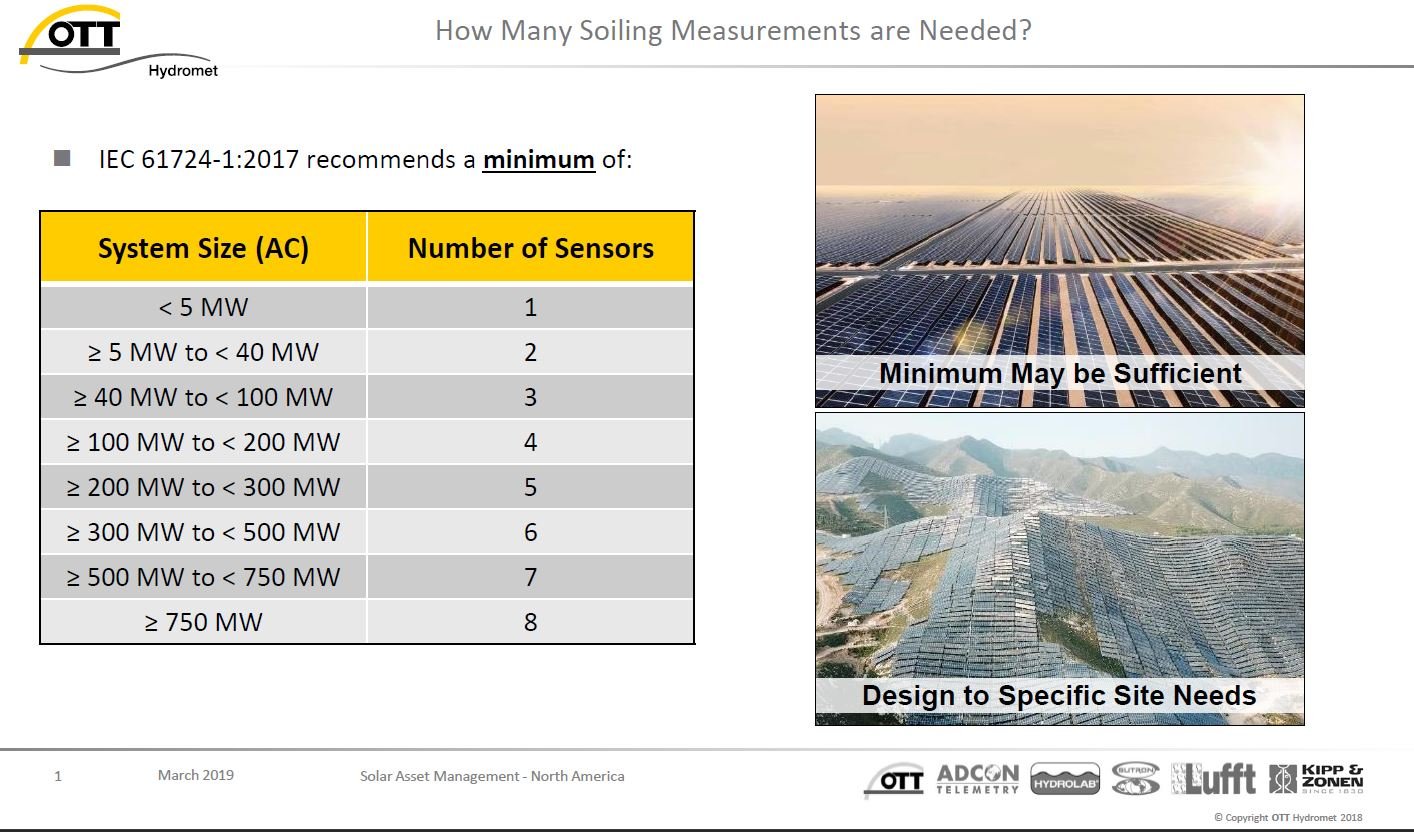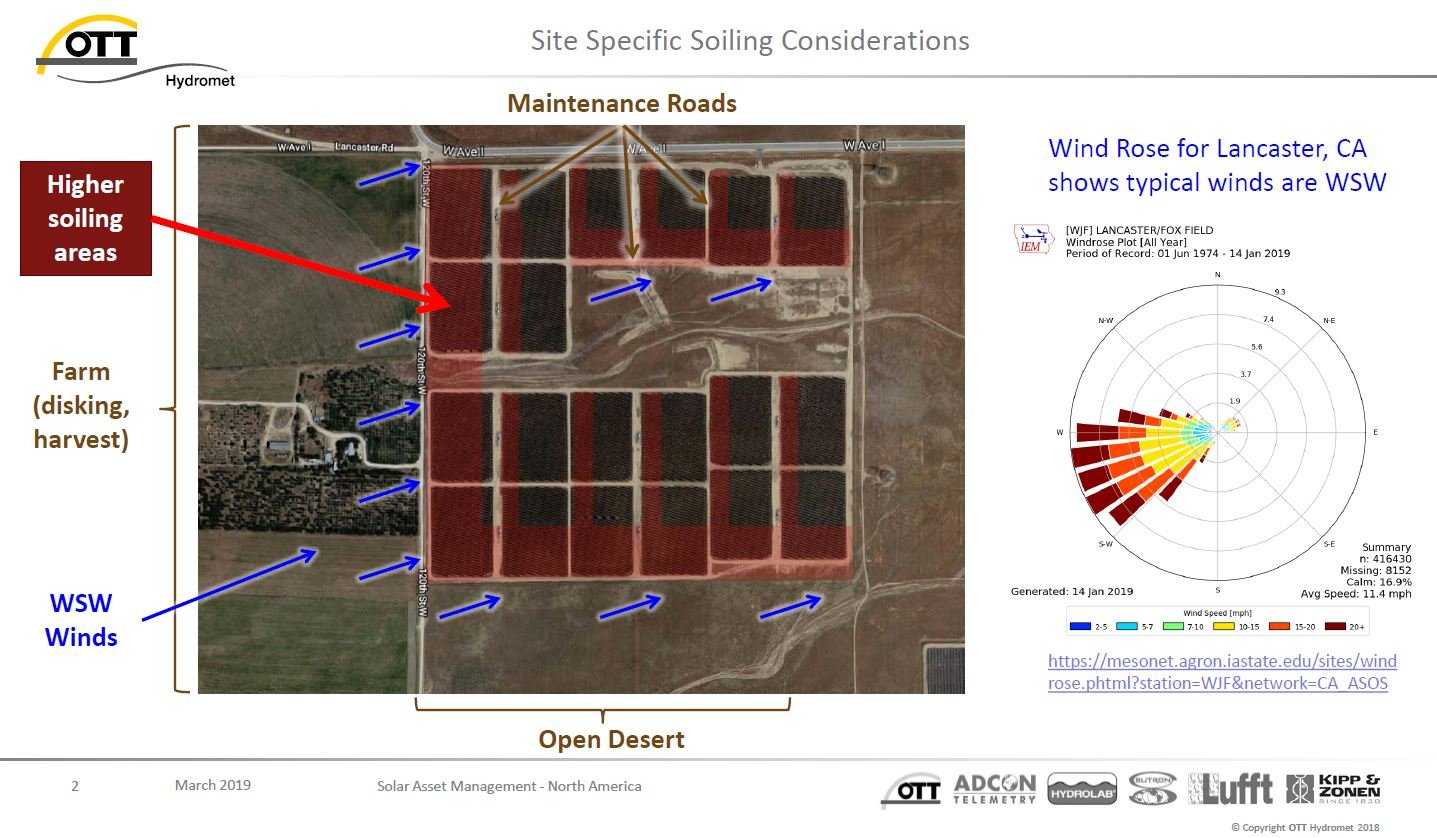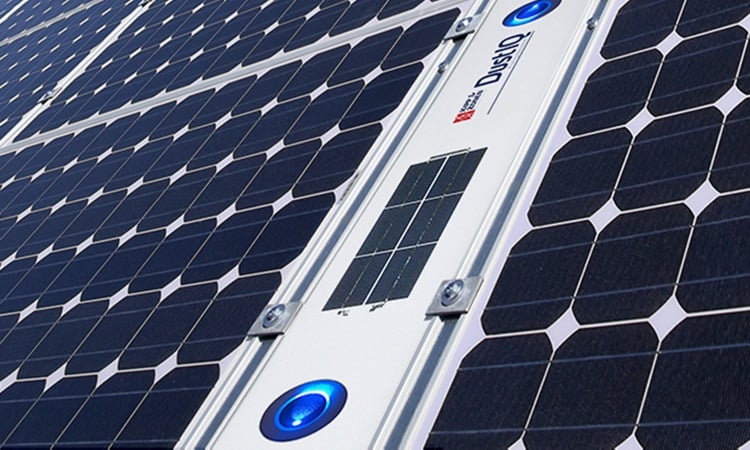Contamination (soiling) from dust, sand, pollen, salt and other particulates reduces the performance of PV panels over time, leading to power output losses. The panels must be cleaned—but which panels, and how often? On a sprawling solar farm, not all panels soil at the same rate. Not all experience the same conditions, topographies or weather patterns.
That's where soiling stations come in. As more solar PV plants optimize their operations, they are using dedicated soiling measurement sensors and stations to monitor soiling losses.
We asked Damon Nitzel of OTT HydroMet to share his knowledge of soiling stations and how they can help optimize yield and save money over the long term. OTT HydroMet is the parent company of Kipp & Zonen, whose solar instruments are widely used in climate research and renewable energy. They are the maker of the DustIQ Soiling Monitoring System.
What is a Soiling Station?
A soiling station, or soiling sensor, is used to help operators determine when and where panels need cleaning. It is a way of assisting PV plant operators and quantifying power loss.
A soiling station doesn't provide a physical measurement of the dust and particulates on the actual panels. Rather, it's used as a reference point to understand what percentage of power loss is due to soiling. It provides a representative value that’s meant to define a region of soiling and give that approximation.
Where are Soiling Stations typically used (what types of projects and/or applications)?
"To clean or not to clean"—that is the main consideration.
Typically, soiling is monitored on utility scale and commercial and industrial solar PV sites—500 kilowatt to 1 megawatt on the low end.
There are many factors that go into the decision to monitor soiling or not, such as site location, the rate of soiling, local weather patterns, and cleaning costs.
.jpg?width=4368&name=DustIQ_application_image_%20(3).jpg)
Are Soiling Stations required or recommended for solar PV projects? Are they a Utility, PPA, and/or an Owner based requirement to have?
The IEC 61724-1 Class A standard includes a soiling standard, with recommendations for the number of sensors and so forth. In order for a solar PV plant to achieve Class A status for IEC, there must be a soiling station onsite per those recommendations. Does every plant meet those standards? No, but there are quite a few plants that do have that as a goal.
At the end of the day, the decision on whether to implement a soiling station is driven by asset owners and their financial goals. In addition to soiling, there are many factors that cause losses at a solar PV farm, such as inverter failures and misaligned trackers. Soiling is a low-hanging fruit that operators can take action on to increase power output.
Even if a soiling station isn't specifically required, it may be necessary in order to meet performance standards for the plant as defined by the PPA. It's up to the operator to ensure these power output requirements are met, and cleaning the panels efficiently, effectively and only when needed is an important part of that. More and more, soiling stations are being seen as a necessity.
Many owners, developers and financiers are beginning to require soiling stations during the building and commissioning stages of the plant. They want to know what the soiling is at the site during construction, so when they do commissioning tests and the output isn’t 100% optimal, they have a better understanding of the reasons why.
How many Soiling Stations are typically needed? Is it based on the topology, size and location of the solar facility?
As mentioned earlier, the IEC Class A standard contains recommendations for the number of soiling stations per megawatt. However, not all soiling stations fall neatly under those guidelines. The standard is based on traditional two panel soiling systems, while many facilities now use other types. This makes the standards a bit unclear depending on what type of technology you're using.
From a big picture perspective, soiling is a tough measurement to make. There are a slew of site-specific variables to consider. These include not just the site size, but the local topology, local weather patterns, prevailing wind direction and wind speed, seasonal soiling rates, cleaning zones, and local soiling sources like roadways, farm fields, open deserts, orchards, forests that contribute pollen, exhaust from planes, and factory emissions.
Ultimately, you have to consider the individual site and how uniform it is. That helps determine how many soiling sensors are required to get the right level of data granularity to be representative of your site.

Does the type of Soiling Station matter (RDE, reference module or other)? Why do some Soiling Stations require another solar panel (i.e. reference cell) to compare against?
Each type of soiling monitoring solution has its different strengths and weaknesses. The type matters, but it depends on which strengths and weaknesses apply to your site.
Traditional two panel systems monitor using a clean and a dirty panel. They compare the power output of the panels to calculate the soiling ratio and transmission loss. They require two panels because they must have one clean and one dirty in order to get the transmission loss measurement.
Newer optical solutions like the DustIQ Soiling Monitoring System measure the loss of light transmission that the panels experience due to soiling. Unlike the two-panel system, DustIQ doesn't require a second panel to use as a reference module for daily measurements. Instead, it uses clean and dirty short circuit current measurements as the basis for comparison. The optical measurement is calibrated against this reference value. Calibrating the sensors is done using a silicon-cell module.

Are some types of Soiling Stations more accurate than others?
Again, this goes back to different stations having different strengths and weaknesses.
For example, it's generally accepted that the traditional two panel systems are an accurate method for calculating transmission loss. They have a large surface to collect dust and that reduces spatial variability.
But what about single-axis tracker installations where the two panel systems don’t rotate like the panels do? This may mean that the two-panel surface is no longer a representative sample of how the PV panels are soiling. Using soiling sensors that mount on trackers should provide a more representative surface, but does a smaller design affect the accuracy of the sensor to measure soiling? It's not a straightforward answer.
The best approach is to be as representative of the surface as possible, while maintaining accuracy of soiling on the surface of the sensor. These were two key design goals for the DustIQ.
Do Soiling Stations require initial calibration, on-going calibration or maintenance?
Traditional two panel systems don't require calibration. However, the panels do drift over time, so you need to make sure that the age and performance of the soiling system panels are similar to the actual panels onsite. Disparities may develop over time.
Optical systems do require calibration but may do so with internal hardware. The DustIQ comes calibrated from the factory, and you can improve that calibration for local site properties. The standardized soil that is used for the factory calibration won’t be identical to the end site; the local calibration adjusts the calibration factor based on those local properties, improving the quantitative soiling value. The local calibration is not required to monitor soiling trends and once local calibration is collected there's no routine maintenance costs for the life of the sensor.
Are all Soiling Stations self-cleaning, or do they require someone to travel to the facility to clean them?
Traditional two panel systems come either with or without an automated cleaning system, which typically requires water or some kind of moving parts. The cleaning interval, whether automated or manual, depends on how often the site manager wants to have soiling data. IEC 61724-1:2017 calls for 1-minute data collection but in practice evaluation happens daily, weekly, or another site specific interval.
Automated or self-cleaning systems still require some maintenance. A maintenance technician needs to go onsite to fill up the water, fix moving parts that wear or break in dusty environments, etc. That's been the industry's main concern with two panel systems—that they're a big system that requires boots-on-the-ground upkeep.
Optical sensors are intended to reduce the need to go onsite by eliminating maintenance for water or moving parts. Whether or not they can be cleaned automatically depends on the placement within an array and the cleaning method being able to cover the sensor.
The DustIQ is designed to mount right next to the panel and have the same width as the short side. In this setup, an automated cleaning robot could clean the DustIQ at the same time as the panel. Because the surface of the sensor is cleaned at the same time as the panel, the surface remains representative of the panel surface.
What are long term savings considerations, if one was to invest in Soiling Station(s)?
There are two key ways soiling stations can help save money over the long term.
1. You can increase your cleaning efficiency by forecasting the best times to clean.
Will selling more power overcome the cost of cleaning? If you know what percentage of power loss is due to soiling, how much you're selling power for, and how much it will cost to clean, then you can calculate whether it's worth recovering that lost power output in order to sell more.
You can also use the soiling data to forecast trends over time, in order to proactively create cleaning schedules that make sense for your plant rather than scheduling less efficient, routine cleaning two or three times a year. You can factor in weather patterns—knowing what times of year tend to have more pollen, for example, or when you can forecast big storms that clean the panels naturally.
2. You can troubleshoot power output losses more effectively and efficiently.
Monitoring the trend of soiling over time with the trend of power loss over time helps to more quickly identify and troubleshoot the source of a power loss.
For example, if your soiling sensor reads 3% soiling but you're experiencing a 3.4% power loss, you can see if the trend matches. Perhaps you have little rain events and things of that nature, and you see spikes and a steady decrease at the same rates. You can deduce that the actual power loss is 3.4%, and it's all due to soiling.
However, what if you're monitoring trends and suddenly the power loss deviates from that trend? It may only be a 2% or 3% difference, but it's a significant, sudden deviation. That's an indication that something on the site is wrong, like an inverter failure, wild turkeys eating the wires, or one of the many other strange things that can happen at solar sites and cause power loss.
This information not only saves operators time in diagnosing issues, but it helps prevent unnecessary truck rolls to the site when trying to troubleshoot power losses. Every time you save a truck roll, you're saving money.
What are some specific benefits of the DustIQ soiling station?
1. DustIQ has a significantly lower total cost of ownership.
It doesn't require routine cleaning, water or moving parts, which minimizes maintenance costs over the life of the sensor.
2. The surface size is a close mimic to the PV panel surface.
It is not a full PV panel, but the soiling surface is the size of the short side of a typical PV panel which helps reduce spatial variability in soiling deposition. The DustIQ uses soda glass that's used in panel manufacturing, and for frame models, similar aluminum frames.
3. Soiling measurements are available 24 hours a day.
The DustIQ is an optical soiling sensor that doesn't require sunlight, making measurements available at solar noon, sunrise, sunset, and even in the dark if needed.
How is that possible? It uses an LED inside the sensor that emits light that then reflects off soil back down into a detector. As soiling increases, the reflection increases, and we monitor the increase in reflection as our measurement. We then relate that to the amount of soiling on the surface, and that's how the optical measurement works.
DustIQ also picks up on dew formation in the middle of the night. This is beneficial to identify the type of cleaning that you do. If you have dry dust versus dust that’s been wet and cemented to the panel surface, the method of cleaning may need to be changed.
4. Two sensors provide redundant and/or top and bottom panel measurements.
Having sensor redundancy gives you confidence in your data. If you’re measuring the DustIQ vertically, you have likely noticed that soiling on panels tends to run towards the bottom as they get wet, making the bottom of the panels dirtier than the top. That's a useful piece of information as well.
5. It has a back of module temperature sensor and measures tilt angle.
If the DustIQ is mounted in the plane of array on the tracker, the internal tile sensor serves as a data validation check that it's still mounted properly on your equipment, at the correct angle. This helps make sure the DustIQ is a representative surface of the actual panels.
6. You can daisy chain up to three DustIQ units together.
This helps increase the granularity of your data, especially for sites that have high amounts of soiling, strange topographies, and other factors that result in having panels mounted at different angles with different wind patterns. Daisy chaining gives a bit more flexibility on how to send the data back to the operations center.
7. The DustIQ can be cleaned with the same tools that are used for cleaning the PV panels, at the same time.
This includes most automated cleaning robots, because the DustIQ is mounted directly next to the panels. You don't have to have a technician go onsite and think about specifically cleaning the soiling station while they're cleaning the panels.
How can OTT HydroMet help people learn more about Soiling Station and other MET related sensors, technology and their benefits?
The next step, now that you have a basic understanding of soiling stations from this article, is to read the OTT HydroMet soiling whitepaper. It goes into depth about solar module soiling and its effects. After you feel comfortable with soiling, you can reach out to your meteorological (MET) station provider. They can help you with the specifics on how the data can integrate with other weather station data.
Nor-Cal's Solar PV Operations training also covers MET stations, soiling stations, sensors, and how the data can be utilized to measure and improve solar power plant performance. You can see and register for upcoming training dates here.




